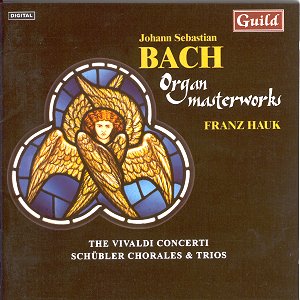Johann Sebastian BACH
Organ Masterworks.
 Franz Hauk on the Klaus organ
of Ingolstadt Munster
Franz Hauk on the Klaus organ
of Ingolstadt Munster
 GUILD GMCD 7221 (DDD)
[78.44]
GUILD GMCD 7221 (DDD)
[78.44]
Guild

Another winner from Guild.
Right from the opening piece, the famous Wachet auf, I knew I was
in for a treat. At last, at long last, an organist who plays it at
the correct tempi without that ghastly baroque fussiness. No dawdling …
thankfully.
This is followed by an adaptation of a Violin Concerto in C by Prince Johann
Ernst in a short three movement ritornello form. Again, the organist plays
it with both spirit and verve and it is highly engaging. Baroque music should
always have this vitality. As the sleeve note says this is music of charm
and demonstrates Bach's cleverness as an arranger, among all his other many
talents!
The Trio in G, BWV 586, has a crystal clarity and this is followed by a Vivaldi
Concerto in D minor based on his Opus 3. This transcription may not be as
effective as others. I found the opening of the work somewhat derivative
and slightly tedious but the majesty of the second movement was a welcome
relief. There was a well-judged build up and my admiration for this organist
increased. His really does have style which compensates for the predictability
of the music! I love the mystery he instils into the penultimate movement.
It is almost strange but very convincing! The finale has splendid integration
and not a little excitement. And what articulation … particularly those
repeated notes.
Ach Bleibh bei uns, Herr Jesu Christ is taken from Cantata Six. It
is described as a restless piece. Well, maybe.... but what a theme and the
decorative figurations are simply delightful. Bach played with life and joy!
As I keep saying , "Everyone should play Bach like this." Fortunately more
people are. We are getting away from that boring authentic correctness which
lingers and drags over every detail. The Aria in F BWV 587 is a curious piece
but hear it yourself and see if you can detect what I mean. The next Concerto,
in A minor, again harks back to Vivaldi's Opus 3 published in Amsterdam in
1711. The opening movement teems with a playful joy which is not exaggerated.
The purists may not like me saying this but this is fun music. It has a wonderful
ability to involve you and "turn your weeping into joy." I found the stringendo
off-putting and I felt the tempo should have remained constant but this is
a minor point.
There follows four of the Schubler Chorales, a trio. and two more 'Vivaldi'
concertos.
I do not wish to deter from this highly impressive disc and I do heartily
recommend it but both Linda and I found the sleeve notes very confusing.
It is not always clear what the writer is saying or means ... or both. He
would have done better to say directly how Bach worked these transcriptions
and how the originals were different. He would have also done better to make
definite statements such as this concerto is a transcription of Vivaldi's
opus 3 no. 11 and that is musically the same, being a direct arrangement
for organ of a concerto for violin and strings...if that is the case. Not
everyone is an expert on Bach's transcription and what is the difference
between a Bach transcription and an arrangement?
I suppose that this definition is important to me as I am a black and white
person. There is much to admire in these performances!
David Wright

